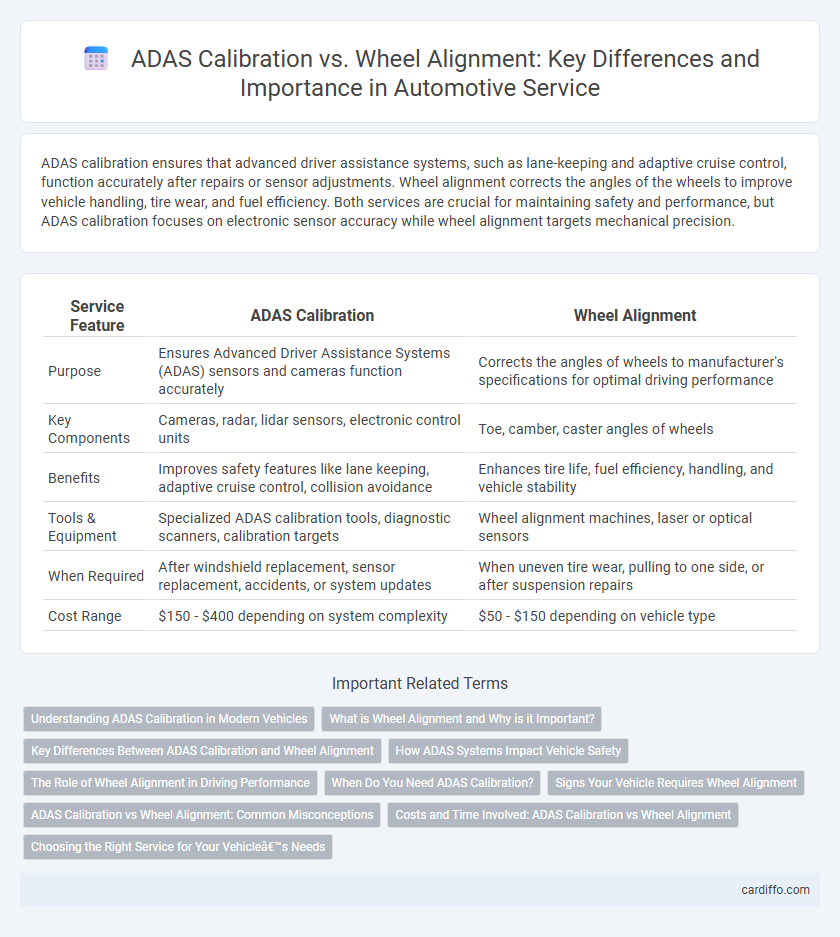ADAS calibration ensures that advanced driver assistance systems, such as lane-keeping and adaptive cruise control, function accurately after repairs or sensor adjustments. Wheel alignment corrects the angles of the wheels to improve vehicle handling, tire wear, and fuel efficiency. Both services are crucial for maintaining safety and performance, but ADAS calibration focuses on electronic sensor accuracy while wheel alignment targets mechanical precision.
Table of Comparison
| Service Feature | ADAS Calibration | Wheel Alignment |
|---|---|---|
| Purpose | Ensures Advanced Driver Assistance Systems (ADAS) sensors and cameras function accurately | Corrects the angles of wheels to manufacturer's specifications for optimal driving performance |
| Key Components | Cameras, radar, lidar sensors, electronic control units | Toe, camber, caster angles of wheels |
| Benefits | Improves safety features like lane keeping, adaptive cruise control, collision avoidance | Enhances tire life, fuel efficiency, handling, and vehicle stability |
| Tools & Equipment | Specialized ADAS calibration tools, diagnostic scanners, calibration targets | Wheel alignment machines, laser or optical sensors |
| When Required | After windshield replacement, sensor replacement, accidents, or system updates | When uneven tire wear, pulling to one side, or after suspension repairs |
| Cost Range | $150 - $400 depending on system complexity | $50 - $150 depending on vehicle type |
Understanding ADAS Calibration in Modern Vehicles
ADAS calibration ensures advanced driver-assistance systems like lane departure warning and adaptive cruise control function accurately by adjusting sensors and cameras after repairs or windshield replacements. Unlike wheel alignment, which focuses on adjusting the angles of tires to improve vehicle handling and tire life, ADAS calibration involves precise electronic adjustments critical for safety features. Proper ADAS calibration is essential for maintaining modern vehicle safety standards and avoiding system malfunctions.
What is Wheel Alignment and Why is it Important?
Wheel alignment is the precise adjustment of a vehicle's suspension, ensuring tires are positioned parallel to each other and perpendicular to the road. Proper alignment enhances tire life, improves fuel efficiency, and ensures optimal handling and safety by preventing uneven tire wear and steering issues. Regular wheel alignment contributes to smoother rides and reduces strain on vehicle components, essential for maintaining overall driving performance and safety.
Key Differences Between ADAS Calibration and Wheel Alignment
ADAS calibration involves adjusting advanced driver-assistance systems like cameras and sensors to ensure precise vehicle safety features, while wheel alignment focuses on correcting the angles of wheels to improve tire wear and handling performance. The calibration requires specialized equipment and software to synchronize electronic safety components, whereas wheel alignment relies on measuring and adjusting mechanical angles such as camber, caster, and toe. Ensuring both ADAS calibration and wheel alignment are performed correctly is critical to maintain vehicle safety, proper function, and optimal driving experience.
How ADAS Systems Impact Vehicle Safety
ADAS calibration ensures sensors and cameras function accurately, directly enhancing vehicle safety by supporting features like automatic emergency braking and lane-keeping assist. Unlike wheel alignment, which improves tire wear and handling, ADAS calibration focuses on the precision of advanced driver assistance systems that prevent accidents. Proper calibration after windshield replacement or sensor adjustment maintains system reliability, reducing the risk of collisions and improving overall driving safety.
The Role of Wheel Alignment in Driving Performance
Wheel alignment plays a crucial role in driving performance by ensuring that tires make optimal contact with the road, promoting even tire wear and precise steering control. Unlike ADAS calibration, which focuses on calibrating sensors for advanced driver assistance systems, wheel alignment directly affects vehicle stability, fuel efficiency, and overall handling. Proper wheel alignment enhances safety and comfort, reducing the risk of accidents caused by uneven tire pressure or poor traction.
When Do You Need ADAS Calibration?
ADAS calibration is essential when advanced driver-assistance systems such as adaptive cruise control, lane-keeping assist, or automatic emergency braking are triggered to recalibrate after windshield replacement, sensor repairs, or suspension adjustments. Accurate calibration ensures that cameras, radar, and lidar sensors function correctly to maintain vehicle safety and performance. Delaying ADAS calibration can result in improper sensor operation, leading to increased risk of accidents and compromised driving assistance features.
Signs Your Vehicle Requires Wheel Alignment
Uneven tire wear, a pulling sensation to one side while driving, and a crooked steering wheel when driving straight are key signs your vehicle requires wheel alignment. Misaligned wheels can cause premature tire damage and negatively impact fuel efficiency. Addressing these issues promptly ensures safer handling and prolongs tire life compared to ADAS calibration, which focuses on advanced driver assistance systems.
ADAS Calibration vs Wheel Alignment: Common Misconceptions
ADAS calibration and wheel alignment serve distinct functions in vehicle maintenance but are frequently mistaken for interchangeable services. ADAS calibration ensures the accuracy of advanced driver-assistance systems such as lane departure warnings and adaptive cruise control, while wheel alignment focuses on adjusting the angles of wheels to manufacturer specifications for optimal handling and tire longevity. Misconceptions arise when drivers assume a wheel alignment automatically includes ADAS recalibration, potentially compromising safety features if overlooked.
Costs and Time Involved: ADAS Calibration vs Wheel Alignment
ADAS calibration typically costs between $200 and $400 and requires 1 to 2 hours due to the precision needed for sensor adjustments. Wheel alignment is more affordable, ranging from $50 to $150, with a shorter service time of about 30 minutes to 1 hour. Both services are crucial for vehicle safety, but ADAS calibration demands higher costs and longer time because of its advanced technology calibration.
Choosing the Right Service for Your Vehicle’s Needs
ADAS calibration ensures advanced driver-assistance systems like lane-keeping and adaptive cruise control function accurately after repairs or sensor replacements. Wheel alignment adjusts the angles of your vehicle's wheels to prevent uneven tire wear and improve handling. Selecting the right service depends on your vehicle's symptoms: choose ADAS calibration for safety feature malfunctions and wheel alignment for steering issues or tire wear.
ADAS Calibration vs Wheel Alignment Infographic

 cardiffo.com
cardiffo.com